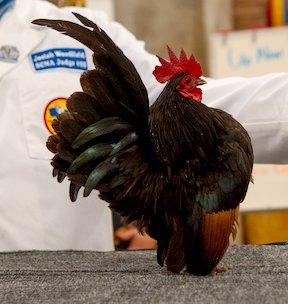
The Serama is considered the world’s smallest chicken breed. But with its chest extended and uplifted, it has a big bird attitude.
“They are evaluated for not just their body structure but also for their performance and engagement on the judge’s table - the flapping, crowing and walking around strutting proudly,” says Donnie Gallagher, chairman of the Serama Council of North America, as well as a Licensed Tabletop Judge for SCNA.
At just 16 oz. (cocks) and 14 oz. (hens) a tabletop is a perfect place for the tiny chickens to perform for judging. According to American Bantam Association standards, the Serama has large wings and a large tail carried vertically. With a short back and vertical carriage, it has a full and uplifted chest.
“The Serama should be friendly and proud birds. They aren’t an aggressive breed, and many folks keep one or two as pets indoors,” Gallagher says.
When he first saw them, he liked their small size and “unique style of performance” and purchased his foundation stock from Jerry Schexnayder from Louisiana, who was the first to import Serama chickens from Malaysia in 2001.
Because they’re small, they struggle in cold weather and during hot/cold temperature swings. Gallagher, who lives in Ohio, keeps his Serama flock in a heated area during the winter.
He sells fertilized eggs year-round ($100/dozen) and hatches chicks in the spring. By late summer/early fall, he sells pairs. Depending on demand and quality, pairs sell from anywhere between $100 to $300.
“I ship early in the week only using USPS Express and include feed and something for hydration. I label the box clearly and do not ship around holidays or if there are reports of delays within the postal system,” he says, adding he gets the permits required to ship to many states and maintains National Poultry Improvement Plan status (certification that the birds are free from Pullorum and Avian Influenza).
Some buyers want Serama chickens for pets, but most are interested in showing and breeding. The breed comes in many colors and patterns and some shows require specific colors.
As a judge and member of the SCNA, Gallagher emphasizes breeding healthy birds that maintain the standard. While some are smaller (called micro and sometimes less than 10 oz.) they are typically not hardy and do not lay eggs or reproduce.
Standard Serama hens start laying eggs at 6 mos. and they can lay up to 125 eggs a year. It takes three to five Serama eggs to equal a Grade A egg from a standard size chicken breed.
For those interested in learning about Serama chickens, Gallagher suggests checking out the SCNA website.
Contact: FARM SHOW Followup, Donnie Gallagher, New London, Ohio (dgseramas@gmail.com; Facebook: DG Seramas; www.scnaonline.org).
